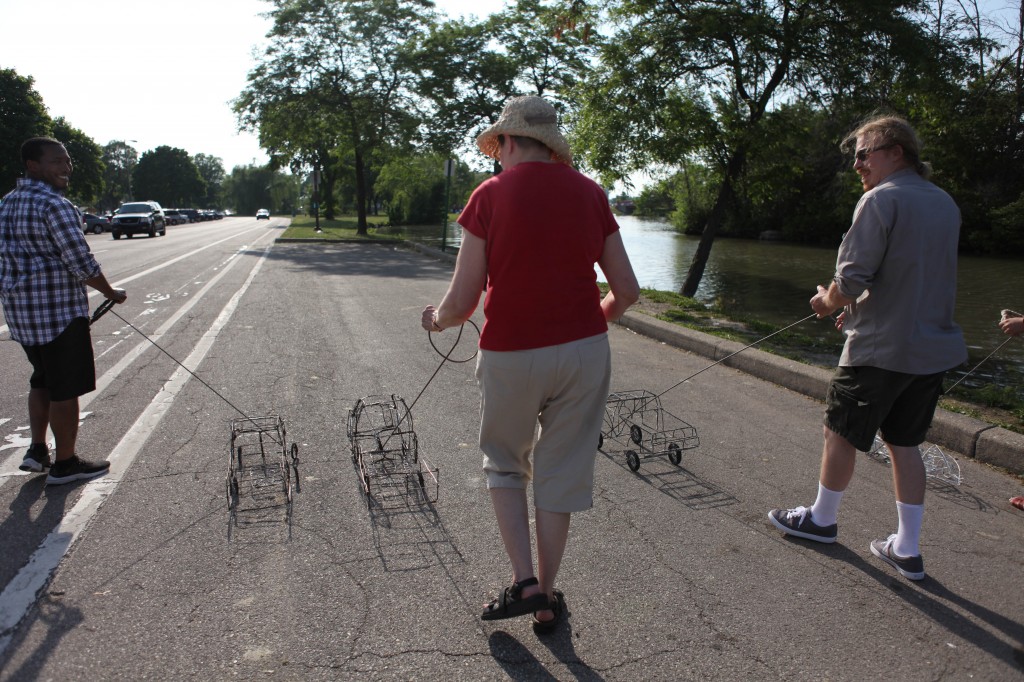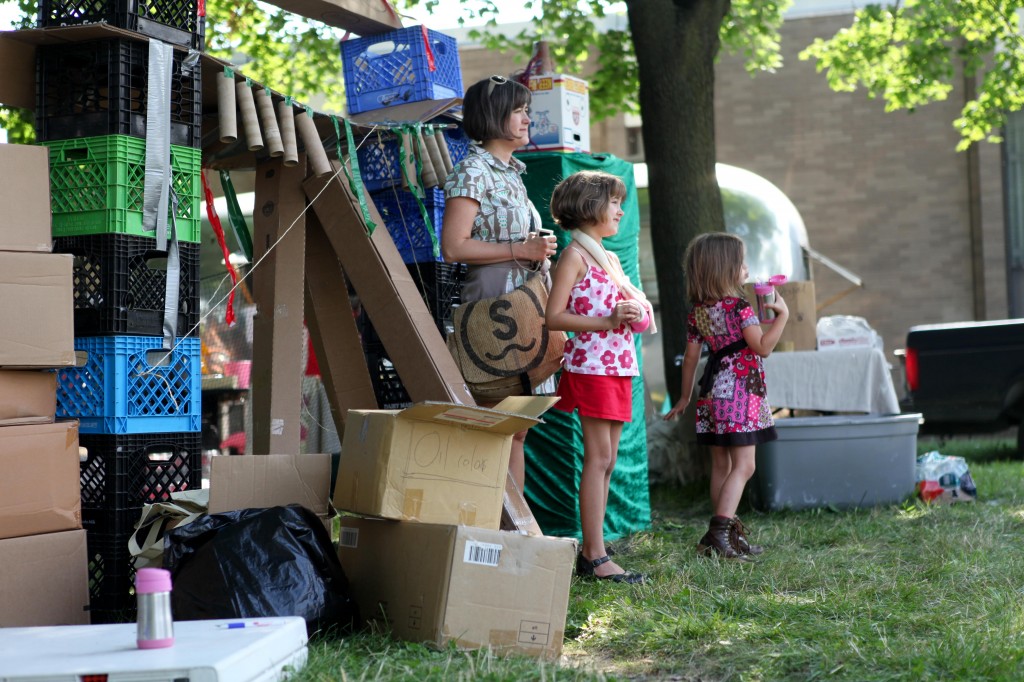
Something to look forward to: Forward Arts
In lieu of the big disappointment caused by the scrapping of the proposed M-1 rail line down Woodward, here are a few thoughts on the unique ways our city is still awesome. Focusing on a particular group who embodies the spirit we need to get through this trough transition period: Forward Arts.
Horace Dodge did not build his automobile in the back of a garage in the Cass Corridor because the city and its investors supported it. The Wright brothers didn’t learn to fly because there was a multimillion dollar governmental program funding them. Innovations in technology and social structure do not happen because some city, or even national group, deems it so. As Detroiters, most of us know this. It is a little sad that we have to approach new city-sponsored projects with caution. “I’ll believe it when I see it,” is an overwhelming new attitude thrust upon residents as they see the projects which they had invested their beliefs and energy into fail time and time again. I have been dreaming of public transit since I learned how magical it can be. I envy friends who live in cities like Chicago and San Francisco. They can travel without the aid of a car and get to enjoy the economic centers that developed around their bus and rail lines. I rate cities that I want to live in by their public transit; Philly and LA: no, San Francisco, Chicago and New York: yes. But, I live in Detroit for different reasons. The same ones that make me feel so heart broken over the city dashing my light rail dreams. I love that this city doesn’t function properly. I wouldn’t be here if it did. You, literally, would not be reading this article because the Knight Foundation would probably not have focused a program here. Detroit’s brokenness is what allows most of us to function in incredible ways that we would not function in in more developed cities. We are capable of recognizing the needs of our communities and rally around new and innovative solutions. So don’t despair too long about the light rail we never had (the rapid bus proposal actually looks awesome). Lets pull ourselves up and work together to figure out what’s next, what can we do to make all of our lives better.
While I am not trying to insinuate that we are going to band together and build our precious light rail system, this week, I learned that another public project focusing on the arts has grim prospects for the future. As the city of Detroit is frantically trying to avoid being overtaken by an emergency financial manager, many projects and initiatives have been pushed aside. I was sent some of the data collected by Community Legal Resources from the artists’ summit (part of the The Detroit Works Project launched this summer to collect data to create a blueprint for our future city) and was surprised by some of the consistencies in the breakout sessions. Participants continuously requested an arts council that is separate from the municipal government, overall advocacy and an appointed liaison to move between the city and its working artists, cultural institutions and businesses. In the event that Detroit Works does fall to the same fate (and even if it does not), I am happy to announce that such an organization already exists. Forwards Arts, founded by Executive Director Dominic Arellano, has been publicly active for about a year and a half so far and has already reached almost 9.000 people with its programming. It created 58 paid opportunities for artists, not including the 51 paid musicians, who worked on a Matthew Barney film and collaborated with cultural institutions, including the City of Detroit, more than 53 times (you can view all of the stats here). Arellano commented, “ We really serve the arts community three ways. We do our own programming in the arts. We offer services to both creative individuals and cultural organizations, like staff sharing and project support. And we are starting to address the really important large, overarching issues that effect everybody in the arts community and beyond, like arts infrastructure, audience and program development and art preservation. I feel like we are art entrepreneurs that develop ideas, big and small, for the arts community and for the city at large. We are both left and right-brain, Eastern and Western philosophy.” As long as I have lived in the city, I have watched different arts advocacy groups start and dissipate because they were either too narrow minded, did not have enough support or not a broad enough vision. But Forward Arts has really stepped it up. Arellano is one of the hardest workers in the game. He and his team of passionate and community-minded folks have what it takes to become the reality participants at The Detroit Works were searching for. According to Arellano, Forward Arts wants to be a “soundboard for the artists community, especially because we work in different art forms — not just one. We want to move between the artists, the cultural institutions and the city.” As many of Forward Arts’ programs take place in public space, where they have garnered permission, it gets the surrounding community involved. “We always try and connect certain projects with a call for community engagement, like Access Arts and doing things in the public realm. We are working in their neighborhood or their park. Depending what the idea is, we allow the community to get involved and help frame their needs. Yet, the same idea can go to a different community and have a different meaning for them.” Arellano said. Another important facet of the organization is its education component. For both youth and adults it is developing programs like the six, eight-to-10 week Access Arts Youth labs happening during the summer. Arellano adds, “Industry wise, it’s one of the first actions of creating artists and art appreciation, which, in the long run, creates an arts industry. Publicly, it creates better engineers, city leaders, better human beings overall and healthier neighborhoods. Art instills a unique skill set that you do not get from others areas of study.” Newer groups, like Forward Arts, who is in the process of receiving its 501c3 accreditation, do not wish to threaten existing cultural institutions, but to serve as a go between. However, they do provide insights into the way future cultural institutions may need to choose a more flexible model of operation. “It’s really hard for cultural institutions, like the Detroit Symphony Orchestra, whose niche is classical music. In some ways, they are in a box because they are only doing one thing.” Arellano concluded “We don’t want to be a major cultural institution but a mid-size one that can still be relevant in a ‘here right now time frame.’”
When asked what is up next for Forward Arts Arellano added, “Next year we’ll continue to grow the programs and events we’ve already executed, while also adding a music program that will include some major industry giants. Our Emerging Arts & Cultural Leaders Detroit program will also be a very cool project that was started a couple of years ago and found a home in Forward Arts. I think there is the potential for us to start to do some things outside of the city and metro-area as well.” The group is always open to new and emerging ideas. You can reach them at [email protected]. Dominic suggests ,“try and get as much down on paper before e-mailing us so you have a better understanding of what you want to do.”
Dominic and the whole Forward Arts team embody what it takes to get things done in a city with the unique infrastructural problems we have here in Detroit. They started because they were passionate about cultivating a vibrant arts culture with realistic goals and expectations. Public support for its efforts followed suit. It’s an unending drive to engage the communities within, and the work is much needed during this epidemic of visiting artists who have little consideration for those that surround them. Forwards Arts is the group that Detroiter’s have been waiting for, built from the ground up, it’s time we get involved and help them on a mission to “Develop and cultivate Detroit’s creative industries by providing support, opportunities and leadership for artists and art administrators; support existing art organizations through partnerships, consulting and business development; and, lastly, preserve Detroit’s artistic history and legacy through education and documentation.”
Recent Content
-
Artsarticle ·
-
Artsarticle ·
-
Artsarticle ·



